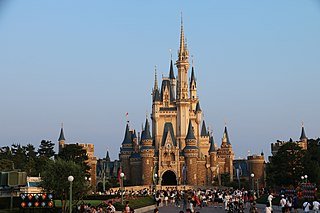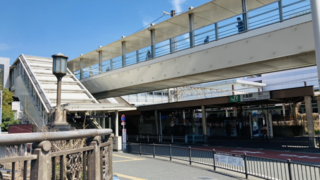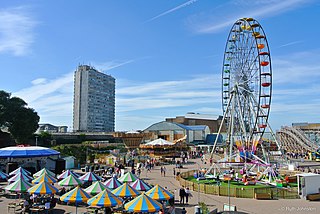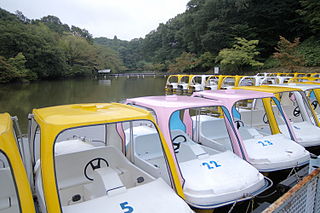
The Tokyo Disney Resort (東京ディズニーリゾート) is a theme park and vacation resort located in Urayasu, Chiba, Japan, just east of Tokyo. The resort is fully owned and operated by The Oriental Land Company under a license from The Walt Disney Company, which constructed and designed the resort and its various attractions through its Imagineering research & development arm.

Minato Mirai 21, often known as simply Minato Mirai and abbreviated as MM, is the central business district of Yokohama, Japan. Initially developed in the 1980s, Minato Mirai 21 was designed as a large master-planned development and new urban center planned to connect Yokohama's traditionally important areas and commercial centers of Kannai and the Yokohama Station area.

Ōfuna Station is a railway station in Kamakura, Kanagawa, Japan, operated by East Japan Railway Company and Shonan Monorail.

Dreamland was an amusement park that operated in the Coney Island neighborhood of Brooklyn in New York City, United States, from 1904 to 1911. It was the last of the three original large parks built on Coney Island, along with Steeplechase Park and Luna Park. The park was between Surf Avenue to the north and the Atlantic Ocean to the south. It was arranged roughly as a horseshoe, with a pier facing south toward the Atlantic Ocean. Dreamland contained several attractions that were larger versions of those at Luna Park, and it included a human zoo, several early roller coasters, a Shoot the Chutes ride, and a replica of Venice. Dreamland also hosted entertainment and dramatic spectacles based on morality themes. Several structures, such as the Pompeiian, Electricity, and Submarine Boat buildings, were dedicated to exhibits.

Dreamland Margate is an amusement park and entertainment centre based on a traditional English seaside funfair located in Margate, Kent, England. The site of the park was first used for amusement rides in 1880, although the Dreamland name was not used until 1920 when the park's Grade II* listed Scenic Railway wooden rollercoaster was opened.

The Ueno Zoo Monorail Line was a 0.3 km (0.19 mi) long suspended railway operated by the Tokyo Metropolitan Bureau of Transportation (Toei). It lies within the Ueno Zoo in Taitō, Tokyo, Japan. The monorail is similar to the Wuppertal Schwebebahn, but has rubber tires rather than steel wheels. Many of the parts manufactured for the monorail were off-the-shelf. The first monorail in the nation, it had two stations, single track, and operated at 600 V DC. The line began operating on December 17, 1957, was suspended during 2001–2002, and has been suspended since October 31, 2019, with the operator citing the high costs of replacing the aging trains. It was officially closed on December 27, 2023. Being located inside the zoo, it only operated on days when the zoo was open, and between 9:40 a.m. and 4:30 p.m., with departures scheduled every seven minutes. The fare for the 90-second trip was 150 yen.
Here is a list of monorails in Japan.

The Shonan Monorail is a suspended SAFEGE monorail in the cities of Kamakura and Fujisawa in Kanagawa Prefecture, Japan. It is operated by the Shonan Monorail Co., Ltd. which belongs to Michinori Holdings, and opened on March 7, 1970, the first monorail of its kind in Japan.

Six Flags New Orleans was a theme park located near the intersection of Interstate 10 and Interstate 510 in New Orleans. It first opened as Jazzland in 2000, and a leasing agreement was established with Six Flags in 2002 following the previous operator's bankruptcy proceedings. Six Flags invested $20 million in upgrades, and the park reopened as Six Flags New Orleans in 2003. Following substantial damage caused by Hurricane Katrina in 2005, the park was closed to the public to make efforts to repair and reopen it. However, in 2006, Six Flags declared the property a total loss, and the park was permanently closed. The lease was terminated in 2009 during Six Flags' bankruptcy proceedings.

Nara Dreamland, or just simply Dreamland, was a theme park near Nara, Japan, heavily inspired by Disneyland in California. It opened in 1961 and was in continuous operation until its permanent closure in 2006 as a result of falling attendance. The park was left abandoned until it was demolished between October 2016 and December 2017.

Joypolis is a chain of indoor amusement parks created by Sega and run by CA Sega Joypolis. Beginning on July 20, 1994 with the original location sited in Yokohama, Japan, Joypolis centers have since opened in several cities in Japan and later China. The parks feature arcade games and amusement rides based on Sega's intellectual properties, original themes, and licensed franchises. Alongside the predecessor Galbo venues and the overseas spin-offs SegaWorld London and Sega World Sydney, they were officially referred to under the "Amusement Theme Park" or "ATP" concept by Sega in the 1990s.
Sega World, sometimes stylized as SegaWorld, is a formerly international chain of amusement arcades and entertainment centers created by Sega.

The Meitetsu Monkey Park Monorail Line was a monorail in Inuyama, Aichi that connected the Japan Monkey Park to Inuyama-yūen Station, operated by Nagoya Railroad (Meitetsu). The line featured steep sections, including one 9.7% grade, and traveled through an artificial canyon for a section. The trip took about four minutes.

Yokohama College of Pharmacy is a private university in Totsuka-ku, Yokohama, Kanagawa Prefecture, Japan. It was established in 2006 on the site of the former Yokohama Dreamland amusement park, converting the existing hotel building into classrooms and a library. It was founded by Yasuhisa Tsuzuki and is operated by his company, the Tsuzuki Integrated Educational Institution. The college's president is Nobel-prize laureate Leo Esaki.

Kodomonokuni Theme Park (こどもの国) is an amusement park near Tokyo, located in Yokohama, Japan. The park's name means Children's Country. As the name implies, it is more oriented towards young children than teenagers. It was founded in commemoration of the Royal Marriage of Prince Akihito and Princess Michiko in 1959, and it was officially opened on May 5, a national holiday of the Children's Day, in 1965. The park is approximately 240 acres (97 ha), and includes such things as a children's petting zoo, a boating lake, and a barbecue site.

Cosmo Clock 21 is a 112.5 metre tall ferris wheel at the Cosmo World amusement park in the Minato Mirai 21 district of Yokohama, Japan. When it first opened, it was the world's tallest Ferris wheel, until the completion of the 108-metre (354 ft) Igosu 108 in Shiga, Japan, in 1992.

The Yokohama Dreamland Monorail (ドリームランドモノレール), formally the Dream Development Dreamland Line was a monorail connecting the Yokohama Dreamland amusement park to Ōfuna Station in Kamakura, Kanagawa, Japan. Operational for barely over a year between May 1966 and September 1967, various attempts to restart or rebuild the line continued for 35 years, until it was finally decommissioned in 2002.

Yokohama Cosmo World is a theme park in Yokohama, Kanagawa Prefecture, Japan. It contains the Cosmo Clock 21, formerly the tallest Ferris wheel in the world. It is since 1999 home to a unique coaster from Senyo Kogyo, named Diving Coaster: Vanish.
















